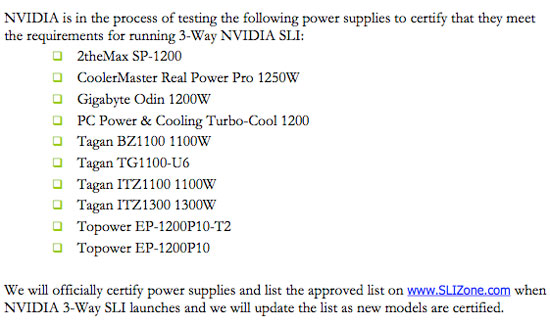NVIDIA's 3-way SLI: Can we finally play Crysis?
by Anand Lal Shimpi on December 17, 2007 3:00 PM EST- Posted in
- GPUs
NVIDIA is in a difficult position. On one front it has the chipset division of AMD, fighting hard to make its own chipsets the platform of choice for AMD processors. On the other front it has Intel, the enemy of its enemy, and a very dangerous partner itself. Intel hasn't been very quiet about its plans for dominating the GPU market, but that isn't for another couple of years, until then, Intel will gladly allow NVIDIA to make chipsets for its processors.
As a company, NVIDIA needs to be able to maintain relevancy in the market. In the worst case scenario, AMD and Intel would each make their own chipsets and graphics cards, leaving NVIDIA with nothing to do. The reality is that NVIDIA still has the best graphics cards on the market and neither AMD or Intel is anywhere close to taking the crown yet. The chipset business is more likely in imminent danger, but NVIDIA does have one trick up its sleeve: SLI.
NVIDIA has some very desirable graphics cards, and it has a tremendous brand in those three letters. Of course, SLI only works on NVIDIA chipsets, thus it's no surprise to see NVIDIA trying to add even more value to the SLI proposition.
The GPU manufacturers, in the past two years, started to run into the same sort of thermal walls that Intel did during the Pentium 4 days. Future GPU designs will be more focused on power consumption and performance per watt, and while that won't kill the very high end graphics market, it will undoubtedly change it. If you'll notice, the first two G92 based products NVIDIA launched were both targeted at the mid range and lower high end segments, there were no 8800 GTX/Ultra replacements in the cards.
It may end up being that the way NVIDIA pushes the envelope isn't by introducing single, very powerful GPUs, but rather by SLI-ing lesser GPUs together. That brings us to today's topic: 3-way SLI.
If you can't tell by the name, 3-way SLI is like conventional 2-card SLI but with three cards.
The requirements for 3-way SLI are simple: you need an NVIDIA 680i or 780i motherboard, and you need three 8800 GTX or 8800 Ultra cards. SLI support continues to be the biggest reason to purchase an NVIDIA based motherboard, thus it's no surprise to see 3-way SLI not work on any competitor chipsets. With three cards you need two SLI connectors per card, meaning that all of the recently released G92 based boards won't cut it.
The graphics card limitations are quite possibly the most shocking, because the 8800 GTX and Ultra are still based on the old G80 GPU, which is significantly hotter than the new 65nm G92 that is used in the 8800 GT and GTS 512. NVIDIA unfortunately only outfitted those new G92 cards with a single SLI connector, so 3-way SLI was out of the question from the start and plus, NVIDIA needed some reason to continue to sell the 8800 GTX and Ultra.
Power supply and cooling requirements are also pretty stringent, NVIDIA lists the minimum power supply requirements as:

And a list of 3-way SLI certified power supplies follows:

We actually used an OCZ 1000W unit without any problems (including two 4-pin molex to 6-pin PCIe power connectors to feed the third card), but we'd recommend sticking to NVIDIA's list if you want to be safe.

The three cards are connected using a new SLI bridge card that ships with all 780i motherboards:

If you don't have this card you can jerry rig a bridge using regular SLI flex cables in the following configuration:











48 Comments
View All Comments
IKeelU - Tuesday, December 18, 2007 - link
When will this nonsense stop? It is perfectly reasonable for a game company to "permit" users to increase the detail if they so choose. On "high" the game looks and runs great on a sub-$400 video card. In fact, on "high" it looks better than anything out there, on any platform. At least with a "very high" setting available, the game will continue to look good a year from now when other games have caught up.andrew007 - Tuesday, December 18, 2007 - link
Uuuh... no, Crysis is not playable at "high" at any decent resolution on my 8800GT and 3.4GHz overclocked quad core Q6600. Decent being 1280 x whatever. And when you drop to medium, the game looks nothing special. Sure, there are a few areas that look great (forest level for example) but overall I was certainly not blown away. Unlike replaying Bioshock in 1920x1200 which this setup is capable of running very smoothly and which looks amazing in DX10. Quite simply, Crysis is one of the worst optimized games ever. At least it doesn't crash, that's something I guess. Looking forward to replaying it in 2 years. Come to think of it, it was the same with Far Cry, it took 2 years to be able to play that game with decent frame rates.JarredWalton - Tuesday, December 18, 2007 - link
There's nothing that says Crytek can't make a game where maximum detail settings exceed the capacity of every PC currently available. We've seen this in the past (Oblivion for one), and then a year later suddenly the game is more than playable at max settings on less expensive hardware. It doesn't appear that Tri-SLI is fully implemented for many titles, and considering the age of Crysis I'd expect more performance over time. Just like many games don't fully support SLI (or support it at all in some cases) at launch, only to end up greatly benefiting once drivers are optimized.FWIW, I'm playing Crysis on a single 8800 GTX at High detail settings and 1920x1200 with a Core 2 Duo 3.0GHz 2MB (OC'ed E4400). It might be too sluggish for online play where ping and frame rates matter more, but for single player I'm having no issues with that res/settings. It's a matter of what you feel is necessary. I'm willing to shut off AA to get the performance I want.
tshen83 - Tuesday, December 18, 2007 - link
First of all, people who will fork over 1500 dollars worth of GPUs will want to play all games at the highest settings. That means highest AA and AF settings. I don't think you used AA and AF in your testing. It is almost pointless to play without AA for such a nice setup at 120fps(bioshock) where you are becoming CPU bound rather than GPU bound.Secondly, your Crysis test used 1920x1200. Why not 2560x1600? Why not 2560x1600 at 4xAA and 16xAF? Crysis at 1920x1200 without AA and AF are severely CPU bound in your case, as you have witnessed that a faster CPU gave you linear scaling.
Third, there is actually no point of testing triple SLI at any other resolution other than 2560x1600. The target audience triple SLI is aimed at are those with 30 inch Cinema Displays.
I think to be fair, you should rerun the benchmarks in a non-CPU bound situation with AA+AF on, you will see the proper scaling then.
Thanks,
eternalkp - Tuesday, December 25, 2007 - link
very good point TshenI have a 30inch monitor.
the 7900gtx was killing my frame rate.
i was getting average 25fps @ 2560x1600, medium, 2X AA, 16X aniso...in FEAR Perseus Mandate.
Just bought MSI OC 8800GTS G92 and very happy with it.
Now i can crank up maximum graphic setting, 4X AA, 16X aniso @ average 40fps...very nice. :D
Crysis is a hot engine, i only get 30fps @ medium, AA off.
YES. what is the point of 3 GPU and have your AA/Aniso off?
game will look like crap.
Crysis recommends 4gb of ram.
kmmatney - Tuesday, December 18, 2007 - link
"Third, there is actually no point of testing triple SLI at any other resolution other than 2560x1600"The point was testing at settings that are "playable". Who cares if the framerate goes from 8 to 12 @ 2560 x 1600. Its unplayable.
I don't see how even an "enthusiast" wouldn't see triple SLI as a wate of money, though.
cmdrdredd - Tuesday, December 18, 2007 - link
The point is that running 1600x1200 is really not anything you shouldn't be able to do with one card. Even 1920x1080 in many games is perfect. Showing off 10000000fps means jack, turn the res and AA/AF up and show us what it can push out.defter - Tuesday, December 18, 2007 - link
The author missed one advantage of 3-way SLI:Of course it doesn't make any sense to spend >$1500 on three 8800GTX/Ultras today, but what about those folks that already have a SLI 8800GTX/Ultras?
For them adding a third card could be a reasonable upgrade option in comparison to replacing both cards with new G92 based cards.
3-way SLI isn't for everyone, but it has its advantages.
praeses - Tuesday, December 18, 2007 - link
I was under the impression that bioshock did not support AA in DX10. If that is indeed the case, that's hardly the fault of the benchmarker/reviewer.Also, I see much merrit in benchmarking at 1920x1200, its a much more common resolution and desktop-friendly resolution given the physical foot print of monitors. Lets be honest, many games aren't sitting 4ft from their displays. At 2-3ft a 24" display which most likely has 1920x1200 is much more comfortable for longer action based viewing. Ideally though they would have a lower dot pitch or simply higher resolution on the smaller screen.
tshen83 - Tuesday, December 18, 2007 - link
One more thing: you are using Vista Ultimate 32bit with 4GB of memory. Since in 32bit, you have 3 768MB Ultras(2.4GB reserved just for video cards) , the system will only see about 1.5GB of memory. That is not sufficient system memory for high resolution benchmarks, especially Crysis.